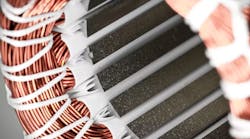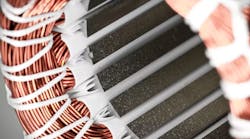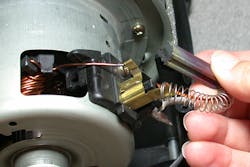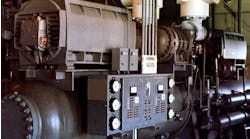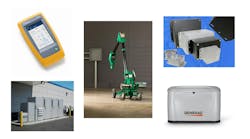Answering Seven Common Questions on Generator and Motor Operation
Rotating equipment is so common, yet so misunderstood, that even highly experienced electricians and engineers are often plagued with questions about their operation. This article will answer seven of the most commonly asked questions. The explanations are brief and practical due to space limitations; however, they will enable you to have a better understanding of this equipment.
Question No. 1: Armature, field, rotor, stator: which is which?
By definition, the stator comprises all of the nonrotating electrical parts of a generator or motor. Also by definition, the rotor includes all of the rotating electrical parts.
The field of a machine is the part that generates the direct magnetic field. The current in the field does not alternate. The armature winding is that which generates or has an alternating voltage applied to it.
Usually, the terms "armature" and "field" are applied only to alternating current generators, synchronous motors, DC motors, and DC generators.
Alternating current generators. The field of a synchronous generator is the winding to which the DC excitation current is applied. The armature is the winding to which the load is connected. In small generators, the field windings are often on the stator, and the armature windings are on the rotor. Most large machines, however, have a rotating field and a stationary armature.
A synchronous motor is virtually identical to a synchronous generator. Thus, the armature is the stator and the field is the rotor.
DC machines. In DC machines, both motors and generators, the armature is the rotor, and the field is the stator. Because the armature is always the rotor on DC machines, many electricians and engineers mistakenly believe that the armature is the rotor on all motors and generators.
| Check out this additional video asset from our team: EC&M Tech Talk - Episode 3: Getting Started on Motor Starters |
Question No. 2: I have relieved the spring tension on my brushes, and they still wear too fast. Why?
Brush wear comes from two basic causes: mechanical friction and electrical wear. Mechanical friction is caused by the rubbing of the brushes on the commutator or slip ring. Electrical wear is caused by the arcing and sparking of the brush as it moves over the commutator. Mechanical friction increases with brush pressure; electrical wear decreases with brush pressure.
For any given brush installation, there is an optimum amount of brush pressure. If the pressure is decreased below this amount, the total wear increases because the electrical wear increases. If the pressure is increased above the optimum amount, the total wear again increases because mechanical friction increases.
Always make sure that the brush pressure is set to the manufacturer's recommended level. If wear is still excessive, you should investigate the type and size of brush being used. Remember, current density (amperes per sq in. of brush) must be correct for the application. Proper current density is required to make certain that a lubricating, conductive film forms on the commutator or slip ring. This film is composed of moisture, copper, and carbon. Insufficient current density inhibits the formation of this film and can result in excessive brush wear.
Also, very low humidity environments do not provide enough moisture for the formation of the lubricating film. If excessive brush wear is a problem in such an environment, you may have to humidify the area where the machine is operating.
| Check out this additional asset from our team: EC&M eBook: The Secret to Better Motor Health |
Question No. 3: What is service factor?
Service factor is the load that may be applied to a motor without exceeding allowed ratings. For example, if a 10-hp motor has a 1.25 service factor, it will successfully deliver 12.5 hp (10 x 1.25) without exceeding specified temperature rise. Note that when being driven above its rated load in this manner, the motor must be supplied with rated voltage and frequency.
Keep in mind, however, that a 10-hp motor with a 1.25 service factor is not a 12.5-hp motor. If the 10-hp motor is operated continuously at 12.5 hp, its insulation life could be decreased by as much as two-thirds of normal. If you need a 12.5-hp motor, buy one; service factor should only be used for short-term overload conditions.
Question No. 4: What is a rotating magnetic field, and why does it rotate?
A rotating magnetic field is one whose north and south poles move inside the stator, just as though a bar magnet, or magnets, were being spun inside the machine.
Look at the 3-phase motor stator shown in the accompanying diagram. This is a 2-pole stator with the three phases spaced at 120 [degrees] intervals. The current from each phase enters a coil on one side of the stator and exits through a coil on the opposite side. Thus, if one of the coils is creating a magnetic north pole, the other coil (for the same phase) will create a magnetic south pole on the opposite side of the stator.
At Position 1, B-phase is creating a strong north pole at the upper left and a strong south pole at the lower right. A-phase is creating a weaker north pole at the lower left and a weaker south pole at the bottom. C-phase is creating an overall magnetic field, with its north pole in the upper left and its south pole in the lower right.
At Position 2, A-phase is creating the strong north pole at the lower left and a strong south pole at the upper right; thus the strong poles have rotated 60 [degrees] counterclockwise. (Note that this 60 [degrees] magnetic rotation exactly corresponds to a 60 [degrees] electrical change in the phase currents.) The weak poles also have rotated 60 [degrees] counterclockwise. This, in effect, means that the total magnetic field has rotated 60 [degrees] from Position 1.
With a more detailed analysis, we can show that the magnetic field strength rotates smoothly from Position 1 to Position 2 as the currents in each of the phases varies over 60 electrical degrees. Analysis of Positions 3, 4, 5, and 6 shows that the magnetic field continues to rotate.
The speed at which the magnetic field rotates is called the synchronous speed and is described by the following equation:
S = (f x P) / 120 where S = rotational speed in revolutions per minute f = frequency of voltage supplied (Hz) P = number of magnetic poles in the rotating magnetic field
If a permanent magnet were placed into this stator, with a shaft that allowed it to rotate, it would be pushed (or pulled) along at synchronous speed. This is exactly how a synchronous motor operates, except that the rotor (field) magnetic field is created by electromagnetism instead of a permanent magnet.
An induction motor rotor is composed of short-circuited windings, and a current is induced in the rotor windings when the rotating magnetic field cuts through them. This current creates a field that opposes the rotating field. As a result, the rotor is pushed (or pulled) around by the rotating field. Note that the induction motor rotor can't rotate at synchronous speed, since the rotating field must cut through the rotor windings to create the torque. The difference between synchronous speed and the actual rotor speed is called the percent slip; it is expressed as a percentage.
Single-phase motors also have a rotating magnetic field. The rotating field required to start the motor is generated from a second winding called a starting winding. After the motor is up to speed, the starting winding is disconnected, and the rotating field is developed by interaction of the stator main winding and the rotor.
Question No. 5: How does an induction generator work?
An induction generator is identical in construction to an induction motor. The stator windings are connected to a 3-phase power system, and the three phases create a rotating magnetic field. The induction generator's rotor is rotated by a prime mover, which turns faster than synchronous speed. As the rotor windings cut through the rotating field, a current is induced in them. This induced current creates a field that, in turn, cuts through the stator windings to create power output to the load.
The induction generator thus draws its excitation from the power system to which it's connected. The induction motor must have synchronous generators connected to its stator to start generating. After the induction generator is operating, capacitors can be used to supply the excitation.
Question No. 6: Why are generator and motor bearings insulated?
The magnetic field inside a motor or generator is not completely uniform. Thus as the rotor turns, a voltage is developed on the shaft longitudinally (directly along the shaft). This voltage would cause microcurrents to flow through the lubricant film on the bearings. These currents, in turn, would cause minor arcing, heating, and eventual bearing failure. The larger the machine is, the worse the problem becomes.
To avoid this problem, the rotor side of the bearing body is often insulated from the stator side. In most instances, at least one bearing will be insulated, usually the one farthest from the prime mover for generators and farthest from the load for motors. Sometimes, both bearings are insulated.
Question No. 7: How do AC generators control vars, voltage, and power?
Although the controls of a generator do interact, the following generalities are true.
- The power output of a generator is controlled by its prime mover.
- Voltage and/or var contribution of a generator is controlled by the exciter current level.
For example, let's assume that an additional load is connected to the output of a generator. The added current flow will increase the strength of the armature's magnetic field and cause the generator to slow down. In order to maintain frequency, the generator's governor will increase the power input to the prime mover. Thus, the additional power required of the generator is controlled by the prime mover input.
In our example here, the net magnetic flux in the air gap will decrease, since the armature increase opposes the field flux. If the field flux is not increased to make up for this change, the generator output voltage will decrease. Thus, the excitation current is used to control the output voltage.
Let's look at another example for further clarification. Suppose an additional VAR load is added to our generator. In this circumstance, the generator output current will increase again. However, since the new load is not "real" power, the prime mover needs to be increased only enough to overcome the additional IR drop created by the extra current.
As a final example, let's assume that we have two or more generators running in parallel and feeding a load. Generator 1 (G1) is carrying all the load (real and reactive) while Generator 2 (G2) is running at zero watts and zero VARS. If the operator for G2 opens the prime mover throttle, G2 starts to feed watts to the system. Since the connected load hasn't changed, both generators will speed up unless G1 throttles back.
As G2 picks up an additional share of the load, it requires an increased field flux. If the G2 operator does not increase the G2 field, G2 will draw its additional excitation from G1, requiring G1 to increase its excitation level. If neither G1 nor G2 increase the excitation level, the overall system voltage will go down.
John Cadick, P.E. is president, Cadick Professional Services, Garland, Tex., an interNational Electrical Testing Assoc. (NETA) member.
